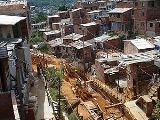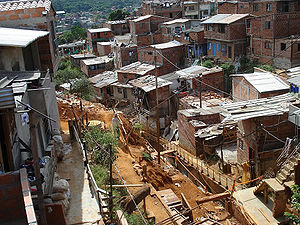
Poverty in Colombia
Encyclopedia

Poverty
Poverty is the lack of a certain amount of material possessions or money. Absolute poverty or destitution is inability to afford basic human needs, which commonly includes clean and fresh water, nutrition, health care, education, clothing and shelter. About 1.7 billion people are estimated to live...
in Colombia
Colombia
Colombia, officially the Republic of Colombia , is a unitary constitutional republic comprising thirty-two departments. The country is located in northwestern South America, bordered to the east by Venezuela and Brazil; to the south by Ecuador and Peru; to the north by the Caribbean Sea; to the...
refers to the serious problem of misdistribution of income, characterized by some of the worst poverty statistics in Latin America
Latin America
Latin America is a region of the Americas where Romance languages – particularly Spanish and Portuguese, and variably French – are primarily spoken. Latin America has an area of approximately 21,069,500 km² , almost 3.9% of the Earth's surface or 14.1% of its land surface area...
. Both the Colombian government and the private organizations have been managing the poverty problem with a superficial approach, focused in charity
Charity (practice)
The practice of charity means the voluntary giving of help to those in need who are not related to the giver.- Etymology :The word "charity" entered the English language through the Old French word "charité" which was derived from the Latin "caritas".Originally in Latin the word caritas meant...
-type programs, with poor outcome, due primarily to the effects on the economy of social, political and economic events throughout the country's history and more recently the effect of the Colombian armed conflict
Colombian Armed Conflict
The Colombian armed conflict or Colombian Civil War are terms that are employed to refer to the current asymmetric low-intensity armed conflict in Colombia that has existed since approximately 1964 or 1966, between the Colombian government and peasant guerrillas such as the Revolutionary Armed...
.
Social Strata in Colombia
Colombia has one of the strictest stratified social systems in the world, because of that the concept of poverty could be relative. One example of this classification can be seen in Colombia's capital BogotaBogotá
Bogotá, Distrito Capital , from 1991 to 2000 called Santa Fé de Bogotá, is the capital, and largest city, of Colombia. It is also designated by the national constitution as the capital of the department of Cundinamarca, even though the city of Bogotá now comprises an independent Capital district...
. Bogota is divided into localities and regardless the actual income of an individual, a person can be socially perceived either as poor or wealthy only depending on what part of the city or locality someone lives. The roots of this phenomenon can be traced back to the outstanding difference in income
Income inequality metrics
The concept of inequality is distinct from that of poverty and fairness. Income inequality metrics or income distribution metrics are used by social scientists to measure the distribution of income, and economic inequality among the participants in a particular economy, such as that of a specific...
between the poor and the rich. In particular, Colombia's employers are not closely observed for equality in employment
Equal Opportunity Employment
Title VII of the Civil Rights Act of 1964 was the first federal law designed to protect most U.S. employees from employment discrimination based upon that employee's race, color, religion, sex, or national origin . The Title also established the U.S...
and has had as a result a job market highly influenced by biased criteria from the employers such as skin color, sex, and even someone's social strata. This social stratification has also come with an economic expense since people that are economically stable and making a good revenue can cheat the health care system and benefit themselves from programs that are specifically made for the poor since their social classification can be deduced simply by knowing where a person lives. It is not clear however how the problem of social classification in Colombia can be solved. Culturally Colombians have suffered of the social stigma of social stratification and it has deeply affected the lives of many if not all Colombians. In this sense the media has played a role on its own. Radio and television have developed entertainment, shows and a diversity of programs basing their target audience
Target audience
In marketing and advertising, a target audience, is a specific group of people within the target market at which the marketing message is aimed .....
according to their social classification. This is particularly noticeable in the big cities where the exclusive upper classes concentrate in luxurious neighborhoods that contrast with extensive areas of more humble dwellings.
Colombia's social strata has been divided as follows and has been extensively used by the government as a reference to develop social welfare programs, statistical information and to some degree for the assignment of lands.
- Stratum 1 : Lowest income.
- Stratum 2 : Low-Middle class.
- Stratum 3 : Middle class.
- Stratum 4 : Upper middle class.
- Stratum 5 : Upper class.
- Stratum 6 : Wealthy. Only the 6% of Colombians fit this category.
Poverty statistics
A CEPAL report included data about poverty in 35% of the general population and 17% extreme poverty, with an estimated 9,654,722 people living in extreme poverty.Unemployment
Colombia has a high rate of unemploymentUnemployment
Unemployment , as defined by the International Labour Organization, occurs when people are without jobs and they have actively sought work within the past four weeks...
and a work market dominated by informal jobs, with few significant prospects for the creation of new work opportunities. The National Department of Statistics in its current report, points out that the unemployment index in the 7 main cities in the country is above 8.6%, for about 3.7 million Colombians of working age. About 32% of the people who do have work don’t have any formal work contract, nor access to the healthcare system
Health care in Colombia
Health care in Colombia refers to the prevention, treatment, and management of illness and the preservation of mental and physical well being through the services offered by the medical, nursing, and allied health professions in the Republic of Colombia....
. 48% of the Colombian work force derive their income from small scale informal economy
Informal economy
The informal sector or informal economy as defined by governments, scholars, banks, etc. is the part of an economy that is not taxed, monitored by any form of government, or included in any gross national product , unlike the formal economy....
such as street vendors and garbage
Waste
Waste is unwanted or useless materials. In biology, waste is any of the many unwanted substances or toxins that are expelled from living organisms, metabolic waste; such as urea, sweat or feces. Litter is waste which has been disposed of improperly...
recycler
Recycler
Recycler is the tenth studio album by American blues rock band ZZ Top, released in 1990.The band had a cameo in the 1990 movie Back to the Future Part III playing an "old west" version of "Doubleback" along with some local musicians....
s. The unemployment situation in Colombia has been described by the CEPAL general secretary, José Antonio Ocampo, as “dramatic”.
Inequality
Colombia's Gini coefficientGini coefficient
The Gini coefficient is a measure of statistical dispersion developed by the Italian statistician and sociologist Corrado Gini and published in his 1912 paper "Variability and Mutability" ....
(a measurement of inequality
Economic inequality
Economic inequality comprises all disparities in the distribution of economic assets and income. The term typically refers to inequality among individuals and groups within a society, but can also refer to inequality among countries. The issue of economic inequality is related to the ideas of...
in wealth distribution) was 0.51 in 2000 and 0.56 in 2006, making it the second-most unequal country in Latin America terms of wealth distribution, after Brazil
Brazil
Brazil , officially the Federative Republic of Brazil , is the largest country in South America. It is the world's fifth largest country, both by geographical area and by population with over 192 million people...
. By 2009, Colombia had reached a Gini coefficient of 0.587, which was the highest in Latin America
Economic recession

Agriculture in Colombia
Agriculture in Colombia refers to all agricultural activities, essential to food, feed, and fiber production, including all techniques for raising and processing livestock within the Republic of Colombia...
, manufacturing
Manufacturing
Manufacturing is the use of machines, tools and labor to produce goods for use or sale. The term may refer to a range of human activity, from handicraft to high tech, but is most commonly applied to industrial production, in which raw materials are transformed into finished goods on a large scale...
, transportation
Transport in Colombia
Transport in Colombia is regulated by the Ministry of Transport.Road travel is the main means of transport; almost 70 percent of cargo is transported by road, as compared with 27 percent by railroad, 3 percent by internal waterways, and 1 percent by air. Nevertheless, Colombia has one of the lowest...
and building industries, which are the main sources of employment in the country. The global growth of these economic sectors, compared with the population growth in the same period gives an index of 0.7, indicating a larger growth in the number of people needing jobs than the number of employment positions on offer.
Literacy
The current index of illiteracy in the country is 7.6%, with areas such as Chocó DepartmentChocó Department
Chocó is a department of Colombia known for its large Afro-Colombian population. It is in the west of the country, and is the only Colombian department to have coastlines on both the Pacific Ocean and the Atlantic Ocean. It also has all of Colombia's border with Panama. Its capital is...
and Sucre Department
Sucre Department
Sucre is a department in the Caribbean Region of Colombia. The department ranks 27th by area, and it has a population of 772,010, ranking 20th of all the 32 departments of Colombia...
having a 16% level. . Probable causes are the Colombian armed conflict
Colombian Armed Conflict
The Colombian armed conflict or Colombian Civil War are terms that are employed to refer to the current asymmetric low-intensity armed conflict in Colombia that has existed since approximately 1964 or 1966, between the Colombian government and peasant guerrillas such as the Revolutionary Armed...
and the insufficiency of funds destined for education in Colombia
Education in Colombia
Education in Colombia includes nursery school, elementary school, high school, technical instruction and university education. A typical colombian studies 11 years and attempts to complete the secondary level of education.- History :...
. The current literacy rate for the nation stands at 92%.
Malnutrition
Over 500 000 children under 5 years old (about 13%) in Colombia suffer from acute malnutrition and up to 15% suffer from chronic malnutrition, the most affected areas being BoyacáBoyacá Department
Boyacá is one of the 32 Departments of Colombia, and the remnant of one of the original nine states of the "United States of Colombia".Boyacá is centrally located within Colombia, almost entirely within the mountains of the Eastern Cordillera to the border with Venezuela, although the western end...
and Nariño Department
Nariño Department
Nariño is a department of Colombia named after Antonio Nariño. It is in the west of the country, bordering Ecuador and the Pacific Ocean.Its capital is Pasto, other important cities include Tumaco, Ipiales.-Municipalities:# Albán# Aldana# Ancuya...
.

